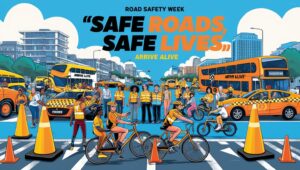Young drivers aged between 17-25 now make up more than a third (38%) of all new dangerous driving endorsements despite this age group accounting for just 7% of all full licence holders*, according to new figures analysed by the UK’s leading road safety charity IAM RoadSmart.
Analysed data** gathered through a Freedom of Information (FOI) request to the DVLA (GB data) reveals that in 2021, a total of 1,585 drivers aged between 17-25 inclusive were issued with DD40 (dangerous driving) endorsements on their licences, making up just over a quarter (27%) of all issued. By 2023, this had increased to 1,928 new endorsements, meaning the proportion of new DD40s for this age group had risen to 36% of all issued. Up to 1st June 2024, there were a total of 1,128 new endorsements, accounting for an astounding 38% of the total issued.
According to the data from the DVLA, those drivers aged between 26-65 accounted for 72% of new DD40 endorsements, with 4,130 added to this age group in 2021. This dropped to 3,378 in 2023, which translated into a proportion of 63% overall. This has fallen further to 60% as of 1st June 2024. Drivers above the age of 66 represent the smallest overall proportion with just 1% of this age group picking up points for dangerous driving between 2021-24. Between 2021 and 2024, the youngest driver with a DD40 endorsement was aged just 13-years-old, well before the legal age of being able to start driving a car. The oldest was 94.
A DD40 is the police endorsement code issued on a licence for dangerous driving***. The number of points can vary from three to eleven depending on the seriousness of the offence and must stay on the licence for four years from the date of the conviction. According to the police****, these are issued when the way a person drives falls far below what would be expected of a competent and careful driver; or if it would be obvious to a competent and careful driver that driving the vehicle in its current state would be dangerous. Typically, this could include behaviours such as:
- speeding, racing, or driving aggressively
- ignoring traffic lights, road signs or warnings from passengers
- overtaking dangerously
- driving under the influence of drink or drugs, including prescription drugs
- driving when unfit, including having an injury, being unable to see clearly, not taking prescribed drugs, or being sleepy
- knowing the vehicle has a dangerous fault or an unsafe load
- distractions may also cause dangerous driving
Research shows that young people in particular are reckless drivers, with a recent IAM RoadSmart commissioned survey***** of 1,000 drivers aged 18-26 revealing that more than a third admit to either filming, taking photos or doing both while driving, with almost one-in-ten (8%) admitting to racing friends on a public road.
According to the Department of Transport, one in five drivers crash within one year of passing their driving test, with nearly 5,000 people killed or seriously injured from a crash involving a young driver in 2022.******
In August 2024, IAM RoadSmart hosted a young drivers’ skills day session at Thruxton circuit as part of the charity’s efforts to upskill younger people on how to become better drivers in a variety of disciplines. The charity also runs Advanced Driving courses throughout the year to help drivers and bikers of all ages improve their skills on the road.
IAM RoadSmart Director of Policy and Standards, Nicholas Lyes said:
“Something is going awry with driving standards among younger drivers when they now account for well over a third of all new dangerous driving endorsements while at the same time making up a small proportion of overall licence holders.
“A form of graduated driver licensing (GDL) should now be considered as part of an updated road safety strategy. We strongly believe that training, upskilling, and wider experience will foster better responsibility and decision making which will make our roads safer.
“However, this should not be the end of it: By extending the learning period and introducing a probationary period, younger drivers themselves must reap the financial benefit of reduced motor insurance premiums and the Chancellor can play a significant role by waiving insurance premium tax on policies that have been taken out through a GDL scheme or a similar training course.
“We maintain our call for social media companies to take more immediate action by promptly taking down uploaded content where law-breaking is being caught on a mobile phone in a moving vehicle.”
* https://www.data.gov.uk/dataset/d0be1ed2-9907-4ec4-b552-c048f6aec16a/gb-driving-licence-data
**
| AGE GROUPING | 2021 | Proportion issued | 2022 | Proportion issued | 2023 | Proportion issued | 2024 (up to 1 June) | Proportion issued |
| Under-17s | 2 | <1% | 14 | <1% | 39 | 1% | 45 | 2% |
| 17-25 | 1,585 | 27% | 1,677 | 30% | 1,928 | 36% | 1,128 | 38% |
| 26-65 | 4,130 | 72% | 3,772 | 68% | 3,378 | 63% | 1,785 | 60% |
| 66-94 | 59 | 1% | 50 | 1% | 55 | 1% | 34 | 1% |
| TOTAL | 5,776 | 5,513 | 5,400 | 2,992 |
*** https://www.gov.uk/penalty-points-endorsements/endorsement-codes-and-penalty-points
**** https://www.police.uk/advice/advice-and-information/rs/road-safety/driving-offences/
*****https://media.iamroadsmart.com/pressreleases/nearly-a-third-of-young-drivers-admit-to-filming-themselves-behind-the-wheel-for-social-media-likes-3338607
****** Department for Transport: Road casualties in Great Britain: Reported road casualties in Great Britain: younger driver factsheet, 2022 – GOV.UK (www.gov.uk)















Interesting article there, but you use the very misleading term “killed or seriously injured” in the statistics.
There is a huge difference in the two. Figures show that the number of those killed on the roads has been around 1800for the last few years. Therefore that must mean 3200 have been seriously injured. A uge difference to the headline figure and very misleading.
Thank you for your feedback Roy